Seaweed Harvest Reporting by Sector Available Online!
As a part of our continued efforts to fulfill our mission, we work in conjunction with the Maine Department of Marine Resources and other government policy makers, recognized researchers from accredited educational institutions, and our sea vegetable and seaweed customers worldwide to develop these general guidelines for the sustainable harvest of this resource.
Click here to download the complete Harvester’s Field Guide to Maine Seaweeds. This handbook is a compilation of traditional harvest information and established research.
Maine Seaweed Council Harvester's Guidelines
Although it is recognized that improper hand harvesting can lead to over harvesting, mechanical harvesting has the potential for removal of far more biomass in less time. For this reason, selectivity should be employed regardless of method of harvest and any form of harvesting should undergo careful scrutiny to verify that it is an environmentally concerned, ecological and sustainable method.| Common Name Scientific Name | Traditional Harvest Season | Traditional Harvest Height | % of biomass removal based on assessment at the beginning of the harvest |
|---|---|---|---|
| Dulse Palmaria palmata | 5/1-10/31 | Should be harvested above the holdfast | 75% per harvest as regrowth permits |
| Bladderwrack, Fucus F. vesiculosus, F. evanescens [syn Fucus edentatus] | Year round | Should be harvested above the holdfast | 30% per year |
| Irish Moss (& false) Chondrus crispus, Mastocarpus stellatus | 6/1-11/30 | Should be harvested above the holdfast | 30% per year |
| Kelp, Fingered Laminaria digitata [syn Saccharina digitata] | Year round | Should be harvested above the holdfast | 30% per year |
| Kelp, Oarweed Saccharina longicruris [syn Laminaria longicruris] | 3/1-8/31 | Should be harvested above the holdfast | 30% per year |
| Kelp, Sugarwrack Saccharina latissima [syn Laminaria saccharina] | 3/1-8/31 | Should be harvested above the holdfast | 30% per year |
| Kelp, Winged Alaria esculenta | 3/1-8/31 | Should be harvested above the holdfast and sporophylls (wings) | 30% per year |
| Nori Porphyra spp. | 4/1-10/31 | Should be harvested above the holdfast | 75% per harvest as regrowth permits |
| Rockweed, Knottedwrack Ascophyllum nodosum | Year round | See below * | 17% per year or 50% per 3 years |
| Sea Lettuce Ulva lactuca | 4/1-10/30 | Should be harvested above the holdfast | 75% per harvest as regrowth permits |
| Wormweed Ascophyllum nodosum f. scorpioides | Year round | May be harvested in its entirety | 75% per harvest as regrowth permits |
| * As defined by the Maine Dept. of Marine Resources Regulation 29.05: (1) "The lowest lateral branches shall remain undisturbed and attached to the main stalk of the rockweed that is attached to the substrate; and (2) a minimum of 16 inches of the rockweed shall remain above the holdfast" |
Click here to download the above Harvest Guidelines as a pdf.
UPDATE: In 2013, the Department of Marine Resources began the challenging task of developing a framework of recommendations for the long-term management of the rockweed fishery (Ascophyllum nodosum). The Planning Development Team included a number of members of the Maine Seaweed Council. As new regulations are developed and approved, these Harvest Guidelines will incorporate the changes.
Harvester’s Field Guide to Maine Seaweeds
Introduction
The Maine Seaweed Council (MSC) produces this “Harvester’s Field Guide to Maine Seaweeds” as a supplement to their “Harvest Guidelines for Maine Seaweeds”. The information in this Field Guide complements and supports the recommendations in the Guidelines. Using both documents, current and future harvesters will be able to make more informed choices about what, when, where and how they harvest – a crucial step towards sustainable harvesting in Maine, and the primary mission of the Maine Seaweed Council.
Note
The information in both MSC publications will be updated periodically as needed to reflect new regulatory or scientific information. This document is not intended to be a reference with respect to the laws or regulations in Maine.
Requests
Both this Field Guide and the Guidelines reflect the collective and limited knowledge of MSC members. That’s why it is very useful to hear what you are experiencing in your particular area. Your firsthand evidence and observations are crucial to developing more accurate information with which to better manage our valuable seaweed resources.
- We ask you to notify us at the contacts below concerning anything unusual about the seaweeds in your area.
- We encourage harvesters to keep detailed notes throughout the season, in order to notice trends from year to year.
Cooperative information sharing of best management and harvesting practices increase the likelihood of us all making a sustainable livelihood, perhaps avoiding some of the mistakes of other fisheries.
ROCKWEED, KNOTTED WRACK, ASCO
Ascophyllum nodosum
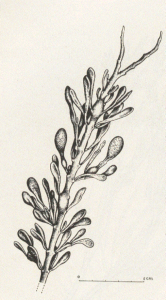 DESCRIPTION: During the cold winter months, rockweed has a very dark green color. In the warmer summer months, portions of the plant will develop a gold, brown color. Anchored to rocks with a disc-shaped holdfast, the stipe divides into a series of branched fronds, each interspersed with air bladders. To distinguish from bladderwrack, note the bladders are not paired and the absence of midribs. During the reproductive cycle (March through June), yellow, spore-bearing receptacles develop throughout the plant. The total length of a mature plant can vary from 3 to 5 feet, or more.
DESCRIPTION: During the cold winter months, rockweed has a very dark green color. In the warmer summer months, portions of the plant will develop a gold, brown color. Anchored to rocks with a disc-shaped holdfast, the stipe divides into a series of branched fronds, each interspersed with air bladders. To distinguish from bladderwrack, note the bladders are not paired and the absence of midribs. During the reproductive cycle (March through June), yellow, spore-bearing receptacles develop throughout the plant. The total length of a mature plant can vary from 3 to 5 feet, or more.
HABITAT: Rockweed grows in the rocky mid to lower intertidal zone. It can be found in protected coves as well as in more open areas. The size of the stipe and air bladders will vary depending on the nutrient levels in the water, the strength of the water flow, and the age of the plant.
BIOLOGY: Rockweed is a perennial brown seaweed, reproducing from spores that are released from receptacles (spore sacks) about the size of a pea, attached throughout the plant by short stalks. These occur during late May to early June and usually drop off during the summer primary growing season.
SUSTAINABLE HARVESTING: Rockweed can be harvested in small amounts year around, but most harvesting is done during the summer months after the reproductive cycle is completed. Harvest methods vary: from open boats with specially designed harvesting rakes, or from land with a knife or sickle at low tide when the plants are exposed, or from boats with a mechanical harvester using a rotary or sickle-bar cutter. The key to sustainability is not the method of harvest so much as the amount of the harvest and the care of the harvester. As stated in the Harvest Guidelines, no more than 17% annually or 50% every 3 years of the standing biomass of an area should be harvested. Since rockweed continues to grow after harvesting it is essential to leave the lowest lateral branches of each plant and at least 16 inches of growth (see Harvest Guidelines). Whatever method of cutting is used, it must be gentle enough not to dislodge the holdfasts.
HANDLING: As with other brown seaweeds, harvested rockweed should not be left in nets, bags, or large piles for long. Warm temperatures will start to break down the seaweed and alter the nutritional value of the plants. It should be sun or mechanically dried to a level of 10% to 20% moisture as soon as possible. It should then be bagged in non-translucent, moisture proof containers and stored in a dry place. If destined for the fresh market (for packing seafood), plants should not be allowed to dry out at all, and can be kept refrigerated or iced to maintain freshness.
WORMWEED
Ascophyllum nodosum, f. scorpioides
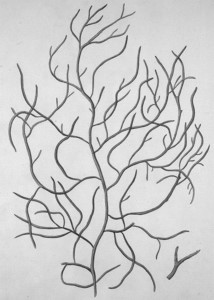 DESCRIPTION: Mature fronds are yellow in color. A short stipe from the holdfast gives way to multiple branches or “fingers” that intertwine with neighboring plants to form hand-sized or larger clusters. Small air bladders are interspersed throughout the plant and yellowy-orange spore sacs may be noticeable during the plant’s reproductive phase.
DESCRIPTION: Mature fronds are yellow in color. A short stipe from the holdfast gives way to multiple branches or “fingers” that intertwine with neighboring plants to form hand-sized or larger clusters. Small air bladders are interspersed throughout the plant and yellowy-orange spore sacs may be noticeable during the plant’s reproductive phase.
HABITAT: Wormweed is usually found near the high tide mark in the grasses of salt-water marshes and highly protected areas. Its holdfast is easily dislodged in storms, allowing it to sometimes drift and accumulate in sheltered coves.
BIOLOGY: Wormweed is a perennial, reproducing from receptacles or spore sacs that develop throughout the plant sometime from spring through summer, depending on location along the coast. In the Mid-coast, this occurs towards mid summer. Maximum growth occurs from late spring to early fall.
SUSTAINABLE HARVESTING: Fronds are harvested into clean mesh bags before or after high tide. It is accomplished quickly and selectively by hand, leaving immature and sporing plants, making sure at least 25% of the biomass remains (see Harvest Guidelines.) Rapid regrowth rates in June, July and August (depending on the weather) may allow for additional harvesting of the same area. A visual inspection will indicate if there is enough regrowth of biomass to sustain another harvest.
HANDLING: Freshly harvested plants should be kept as cool as possible and not compressed (producing heat). Delivery to worm dealers should be within a few days of harvest, unless the plants are washed thoroughly, removing mud, and stored in tidal water in mesh bags. Wormweed breaks down even faster than rockweed. Keeping bags cool through refrigeration or icing will slow decomposition and help maintain freshness.
BLADDER WRACK, FUCUS
Fucus vesiculosus
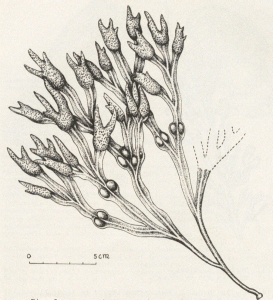 DESCRIPTION: Mature fronds are olive-green with leathery texture. A mid rib and bladders on a moderately narrow blade is characteristic of these species. The bladders are paired on either side of the midrib on F. vesiculosus (see figure). Plants reach 8 to 35 in. long and are attached to a disc-shaped holdfast through a short-wiry stipe. HABITAT: Bladderwrack can be found in the rocky intertidal and upper subtidal zones in exposed to protected coasts in bays and estuaries. It is often found mixed with rockweed (Ascophyllum nodosum) plants. However, pure stands are usually found below or above A. nodosum. It is also predominant in areas of more perturbed substrate (ice scour or small rock/gravel).
DESCRIPTION: Mature fronds are olive-green with leathery texture. A mid rib and bladders on a moderately narrow blade is characteristic of these species. The bladders are paired on either side of the midrib on F. vesiculosus (see figure). Plants reach 8 to 35 in. long and are attached to a disc-shaped holdfast through a short-wiry stipe. HABITAT: Bladderwrack can be found in the rocky intertidal and upper subtidal zones in exposed to protected coasts in bays and estuaries. It is often found mixed with rockweed (Ascophyllum nodosum) plants. However, pure stands are usually found below or above A. nodosum. It is also predominant in areas of more perturbed substrate (ice scour or small rock/gravel).
BIOLOGY: Bladderwrack is a perennial brown seaweed, reproducing from propagules released from receptacles that form at the tip of the blades. Vegetative growth peaks during the summer months.
SUSTAINABLE HARVESTING: Bladderwrack has been traditionally harvested during the spring and summer months. Fronds can be harvested from a boat with a cutting rake or with a knife or sickle at low tide when plants are exposed. As the regeneration of the population is mostly by propagules, it is recommended that no more than 30% of the biomass be harvested annually in a particular area (See Harvest Guidelines) so enough “seeding” material remains. However, scientists from Dalhousie University in Nova Scotia have found that the holdfast is also able to regenerate new shoots; therefore plants should be cut above the holdfast as well.
HANDLING: As with other brown seaweeds, harvested Bladderwrack should not be left in piles; high temperatures will result in rapid deterioration. The harvest should be processed or sun dried to less than 10% moisture as soon as possible by spreading the seaweed on a clean surface. Store in a dry place out of direct light.
SUGAR KELP, OARWEED, SEA BELT
Saccharina latissima [formerly Laminaria longicruris and Laminaria saccharina]
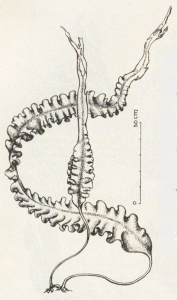 DESCRIPTION: Mature plants vary considerably in size from 5 – 25 ft. long and 10 – 20 inches wide. Anchored by a large branched holdfast, the stipes can be long and hollow (the longicruris form) or short and solid (the saccharina form). The large, flat, olive to golden fronds can have ruffled edges and bullations, or they can be smooth and strap-like.
DESCRIPTION: Mature plants vary considerably in size from 5 – 25 ft. long and 10 – 20 inches wide. Anchored by a large branched holdfast, the stipes can be long and hollow (the longicruris form) or short and solid (the saccharina form). The large, flat, olive to golden fronds can have ruffled edges and bullations, or they can be smooth and strap-like.
HABITAT: This species of kelp is found in the near shore, subtidal zone, preferring more protected bays, coves and estuaries than S. digitata. Holdfasts attach to ledges, stones, mussels, pilings, even ropes – forming dense beds where substrate is firm, to thin clumps where bottoms are mostly mud. It can tolerate brackish water, tidepools, and strong currents, especially in areas of continuous flow, such as is found in reversing falls.
BIOLOGY: S. latissima is considered a perennial, with a life span of several years. Mature fronds thicken to and darken to form the sorus, or spore producing tissue near their ends from early summer to late fall. New plants usually appear in the spring, but can be found throughout the summer and fall depending on habitat. Older plants have thicker, darker stipes and sloughed off “tails”, where sporing material has eroded.
SUSTAINABLE HARVESTING: Traditionally the fronds are harvested when mostly a translucent golden brown, with a minimum of dark “sporeband”. To allow for regeneration, blades are cut above the meristem, about 6” above the stipe, to allow the blade to regrow. If plants are harvested at the stipe, it is important that not more than 30% of removal occurs to allow for continuance of the bed. Harvest season is typically March-August, depending on water temperature, depth of bed, currents, predation, or appearance of epiphytes, etc. Dense beds can tolerate more biomass removal than thinner, sparser beds (spore settlement increases with bed density). Generally, cutting mature fronds floating at or near the surface at low tide, leaving an under-story of younger, shorter plants, will assure a beds continued productivity. Care must be taken not to dislodge holdfasts while cutting, particularly in shallow, soft bottoms. Dragging or indiscriminate cutting may severely compromise substrate integrity and bed density.
HANDLING: Cut plants must be kept covered, cool and moist until the start of the drying process. Traditionally, individual fronds are hung on clips or clothespins after being trimmed of any eroded “tails” or periwinkle perforated “ruffles”. Thoroughly dried until brittle, fronds are allowed to soften with ambient evening moisture before storing whole in plastic lined boxes. More than 10-15% final moisture invites precipitation of mannitol on outside surfaces, or even a brown mushroom-smelling mold.
HORSETAIL KELP, FINGERED KELP, DIGITATA
Laminaria digitata
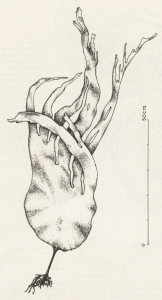 DESCRIPTION: Mature plants are olive brown to almost black, and rubbery to the touch. Dense holdfasts lead to short solid stipes of 6 to 12 in., supporting broad thick blades that quickly separate into multiple “fingers”, each 1 to 3 in. wide and 1 to 5 ft. long.
DESCRIPTION: Mature plants are olive brown to almost black, and rubbery to the touch. Dense holdfasts lead to short solid stipes of 6 to 12 in., supporting broad thick blades that quickly separate into multiple “fingers”, each 1 to 3 in. wide and 1 to 5 ft. long.
HABITAT: Fingered kelp thrives in cold, turbulent water just below the intertidal zone to very deep sublittoral, occasionally seen at the surface at the very lowest tides, or in tide pools. Deep beds are dense, shallow beds are sometimes mixed with Alaria esculenta, or occasionally S. latissima.
BIOLOGY: Fingered kelp is a brown algal perennial, reproducing from spores released from the “fingers” of mature plants. According to research in Nova Scotia, recruitment is continuous but peaks in the fall months. Maximum linear growth occurs during spring and summer months. Annual natural mortality is 40-50%.
SUSTAINABLE HARVESTING: Along the Downeast coast, fingered kelp is traditionally harvested from a boat or from land at the lowest spring and neap tides. Diving has also been used. Nearshore plants of 1-3 ft. are cut where stipe meets frond with a knife. Plants harvested for human consumption are relatively young, with clear, translucent “fingers”, before most sporing has started. In Maine, no more than 30% of a bed’s biomass is harvested in a year (see Harvest Guidelines). Holdfasts are left undisturbed. Older, heavily sporing plants and small, developing fronds are left. Tide pool beds are more vulnerable to over-harvesting than deeper-water beds. In Nova Scotia, no more than 1/3 of a bed may be harvested in a year, and for smaller, less dense beds, a two-year period without harvesting is recommended.
HANDLING: Due to fingered kelps’ high polysaccharide gel content, harvested plants must be kept cool, covered and dried as soon as possible, to avoid stressing the plants and releasing the slippery gel. Traditionally hung to dry in the sun or heated shed, their thick fronds must be separated to dry fast and thoroughly. Dry plants with more than 10% moisture will precipitate white powdery mannitol on their surface during storage (not desirable for the retail food market). Mold can also be a problem with moist plants during storage.
WINGED KELP, ALARIA
Alaria esculenta
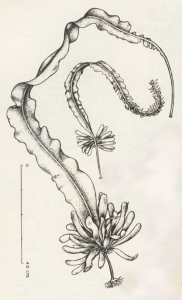 DESCRIPTION: Alaria’s color varies from golden olive to almost black. Mature 1st year plants range in length from 6-12 ft. and 3-6 in. wide. 2nd year plants may be up to 12 in. wide and much longer (or severely truncated by winter storms). Their most distinctive characteristic is a short, flattened stipe that becomes the midrib that runs through the thin, ruffled frond. These sturdy midribs allow blades to survive strong wave action. At the base of the main frond is a set of reproductive spatulate fronds called sporophylls, 2-4 in. long in 1st yr. plants, longer and thicker in 2nd yr. plants.
DESCRIPTION: Alaria’s color varies from golden olive to almost black. Mature 1st year plants range in length from 6-12 ft. and 3-6 in. wide. 2nd year plants may be up to 12 in. wide and much longer (or severely truncated by winter storms). Their most distinctive characteristic is a short, flattened stipe that becomes the midrib that runs through the thin, ruffled frond. These sturdy midribs allow blades to survive strong wave action. At the base of the main frond is a set of reproductive spatulate fronds called sporophylls, 2-4 in. long in 1st yr. plants, longer and thicker in 2nd yr. plants.
HABITAT: Alaria is usually found on rocky ledges just below low tide, predominantly on wave-exposed rocky peninsulas and outer islands on the Maine coast. First year plants may grow slightly higher and survive a few hours of exposure at the spring tides. Sometimes intermixed with S. digitata.
BIOLOGY: Alaria is a perennial, reproducing from spores released from their sporophylls (like wings, or “alaria” in Latin) at the base of the frond. Tiny plants appear on the rocks as early as February, growing rapidly to harvestable 6 ft. fronds by May-June. By the end of August most 1st year fronds have changed color and texture, becoming opaque and slightly red or gray when dried. Some of these plants may over-winter and continue to produce spores along with the deeper, second year plants.
SUSTAINABLE HARVESTING: Traditionally, only the smaller, first year fronds are harvested (for reasons of taste and tenderness). Handfuls are cut with a sharp knife or sickle just below the frond base, leaving as many sporophylls as possible. The midribs of these plants are no wider than ¼ in. and the fronds are translucent and minimally tattered at their tips. Higher beds of first year Alaria may be cut heavily (storms will remove them shortly) as long as no more than 30% of the entire biomass of multi-age plants is removed (see Guidelines). Sporophylls should be left to contribute to the spore mass from older plants in the sublittoral zone. Alaria’s greatest threat seems to be loss of bare rock substrate to other species, such as S. digitata. Clear cutting may lead to this displacement process.
HANDLING: If kept cool and moist, Alaria may be held over up to 24 hours before drying, but best if hung immediately. Most hang handfuls, or clumps, loosely spread across lines, sticks or poles, separating fronds for better air circulation. Good ventilation and low air humidity are essential in getting midribs as well as fronds completely dry. Then slight re-moisturizing to about 8-10% water content allows for packing off in plastic lined boxes. Seal tightly as dried material is very hygroscopic and develops mold easily with too much moisture.
DULSE
Palmaria palmata
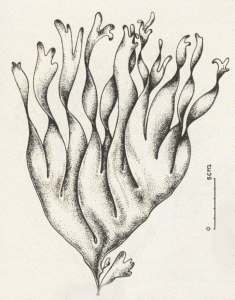 DESCRIPTION: Mature fronds are rose red to reddish purple, 6-10 in. long, 4-6 in. wide. Tiny disc-shaped holdfasts widen immediately into thin elastic fronds that segment into lobes or “stubby fingers.” The plant is hand shaped and hand sized. Dried fronds are dark red to black with fronds stuck together or layered.
DESCRIPTION: Mature fronds are rose red to reddish purple, 6-10 in. long, 4-6 in. wide. Tiny disc-shaped holdfasts widen immediately into thin elastic fronds that segment into lobes or “stubby fingers.” The plant is hand shaped and hand sized. Dried fronds are dark red to black with fronds stuck together or layered.
HABITAT: Usually found attached to rocks, shells or other seaweeds from mid tide to 10 to 20 ft. below the intertidal zone. Dulse often hangs from rock faces or crevices, intermixed with rockweed. On the Maine coast it seems to flourish on rocky outcroppings with moderate turbulence, in nutrient rich reversing falls areas and anywhere there is good current.
BIOLOGY: Dulse is a short-lived perennial. Anywhere from July to September, mature plants develop dark spots or patches on fronds from which spores are released. These develop into microscopic plants that appear on rocks sometime in late winter. Growth is most rapid in May-August, often doubling biomass in two to three weeks. Blades may also grow by budding anywhere along a frond. New plants will often grow from the holdfast of an old plant. Some plants may over-winter in protected areas, many do not.
SUSTAINABLE HARVESTING: Mature blades are hand picked into clean containers at the lowest new and full moon tides, from early May through mid September. Plants should be at least hand sized, mostly translucent, not too thick with spores, and a rich red color. Only attached fronds are harvested, never free-floating or cast up plants. Picking is done selectively and quickly with a loose hand, leaving the holdfasts, immature plants and older, thick sporing plants. At least 25% of the biomass remains (see Harvest Guidelines), along with the tiny plants that have colonized the holdfasts. Rapid growth rates in July and August may allow further harvesting on the next extreme low tides. Visual inspection quickly indicates if there is enough new rosy-red growth in a particular bed. Over-harvesting may allow other seaweeds (greens and browns) to dominate the habitat.
HANDLING: Freshly picked blades are kept cool and covered until spread thinly to sun dry, while culling out foreign material. Fronds shrink and stick together forming a mat that can be rolled up, turned, then unrolled to facilitate rapid and complete drying until crisp. Ambient evening moisture is allowed to slightly “soften” the plants before packing for storage. More than 10% moisture may attract mold. Allowing moisture onto plants before completely dry leads to salts precipitating onto frond surfaces. A good moisture barrier is essential for long-term storage.
IRISH MOSS
Chondrus Crispus
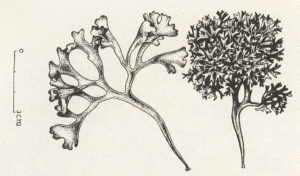 DESCRIPTION: Mature fronds vary from purple to green in color and are 2-6 in. long. Fronds are branched dividing in two at each branching point The stipes are flat and vary from 1/16 in. near the holdfast to 1/2 in. in width. Growth from holdfasts is bushy to loose. Fronds are longer and less bushy in areas of lower water velocity and vary from dark to pale green when deprived of nutrients.
DESCRIPTION: Mature fronds vary from purple to green in color and are 2-6 in. long. Fronds are branched dividing in two at each branching point The stipes are flat and vary from 1/16 in. near the holdfast to 1/2 in. in width. Growth from holdfasts is bushy to loose. Fronds are longer and less bushy in areas of lower water velocity and vary from dark to pale green when deprived of nutrients.
HABITAT: Irish Moss is usually found attached to ledge and rocks sufficiently stable to allow the plant to remain stationary in rapid seawater movement. It thrives in high-energy environments and can be found on ledges exposed to strong wave action or in areas of fast current. It occurs at depths from just above low water to approximately 20 feet or more depending on availability of light. Irish Moss is found both in pure stands and mixed with other seaweed.
BIOLOGY: Irish Moss is a red algal perennial with fronds surviving up to two years or more before being lost. New fronds originate from the holdfast to replace older blades. Growth is dependent on light and nutrients, and to some extent, temperature. The most growth takes place during the long spring and summer days.
SUSTAINABLE HARVESTING: Irish Moss has been harvested from April into September along the Maine coast. The usual method of harvesting has been with long handle (12’+) hand rakes. Some Maine harvesters install shrimp netting or wire mesh nets on their rakes to retain the weed broken loose but not trapped between the tines. The harvester rakes while standing in shallow water or standing in a large skiff.
Irish Moss plants are attached to rocky substrate with small scab-like holdfasts. Single holdfasts support multiple fronds in various stages of development. Harvesting mature fronds allows for rapid development of the smaller growth and encourages new growth. It is extremely important that harvesting methods do not remove or damage the holdfasts. Continued harvesting leaving behind the smaller fronds eventually results in dense growth and the exclusion of competing weeds.
HANDLING: Harvested seaweed should be sun dried or mechanically dried within 24 hours of removal from water. It should be dried to less than 10% moisture. Irish Moss should be picked clean of other weeds and material. The cleaning can take place during or prior to the drying process but is difficult to carry out on a completely dried mixture. Post drying storage locations should be clean and dry.
LAVER, NORI,
Porphyra spp.
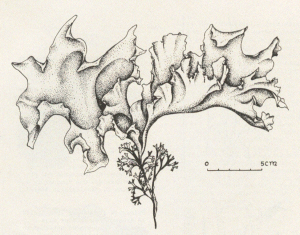 DESCRIPTION: At least 5 different varieties of this red seaweed are found along the Maine coast. Ranging in color from gray-black (P. umbilicalis) to rose red (P. miniata), all plants are stipeless with a single thallus, or leaf, emerging directly from a disc shaped holdfast. Sizes range from small (2-4 in.) and round (P. umbilicalis and P. leucosticta) to large (1-3 ft.) and long (P. miniata and P. amplissima).
DESCRIPTION: At least 5 different varieties of this red seaweed are found along the Maine coast. Ranging in color from gray-black (P. umbilicalis) to rose red (P. miniata), all plants are stipeless with a single thallus, or leaf, emerging directly from a disc shaped holdfast. Sizes range from small (2-4 in.) and round (P. umbilicalis and P. leucosticta) to large (1-3 ft.) and long (P. miniata and P. amplissima).
HABITAT: P. umbilicalis and P. linearis are mostly found in the mid to upper intertidal zone attached to rock faces and crevices, also ropes, pilings and moorings. P. leucosticta usually grows on rocks and even kelp stipes just below the mean low mark. P. miniata and P. amplissima both prefer the subtidal zone and will grow quite large in currents.
BIOLOGY: All varieties have a membranous, or sheet-like growth habit, some one cell thick like P.umbilicalis, others two cells thick like P. miniata. Most produce carpospores that must burrow into calcium rich shells before releasing conchospores, which develop into microscopic plants that will develop into full sized seaweeds.
SUSTAINABLE HARVESTING: Nori or laver is traditionally harvested by hand from May through September, depending on variety and location. Intertidal plants fade in color with too much sun, and periwinkle damage increases through the summer. Best picked quickly with a loose hand like dulse, taking larger plants (some holdfasts will also dislodge), leaving at least 30% of the visible biomass. Spring and summer regrowth rates may permit re-harvest of the same area. Picking an area clean (to the eye) may encourage competing species to dominate the following season. Nori/laver recruitment rates for the Maine coast are unknown at this time.
HANDLING: Once harvested, nori plants will deteriorate quickly and should be dried the same day or put into refrigeration. Usually plants are sun dried by spreading thinly and evenly on nets or mesh racks. Like dulse, the partially dried nori “mats” can be rolled and turned to speed drying. Dry until all plants are crisp, leaving no damp pockets, as mold will develop easily. Double bagging in plastic is preferable to prevent these very hygroscopic plants from slowly attracting moisture.
SEA LETTUCE
Ulva lactuca
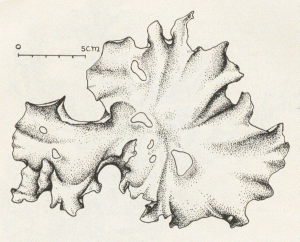 DESCRIPTION: Fronds are bright spring green and leaf-like with undulating wide blades. Blades are up to 8 in tall, heart-shaped, oval or nondescript, occasionally with some small holes. They are like waxed paper to touch.
DESCRIPTION: Fronds are bright spring green and leaf-like with undulating wide blades. Blades are up to 8 in tall, heart-shaped, oval or nondescript, occasionally with some small holes. They are like waxed paper to touch.
HABITAT: Sea lettuce is found in moderately exposed situations on rocks, wood pilings, mussel beds, in pools and quiet shallow waters near the low tide mark. It thrives in brackish water with high organic matter with high levels of nitrogen, and can be found in coastal waters all over the world and all year around.
BIOLOGY: Sea lettuce is a fast growing, opportunistic annual green seaweed. It reproduces from spores released from all over the frond. Normally blades wither after sporulation.
SUSTAINABLE HARVESTING: Sea lettuce is considered a pest to the shellfish industry because of their fast growth and fouling qualities. It may reduce shellfish production by forming extensive mats over shellfish beds or aquaculture facilities in estuaries or shallow bays. For this reason Sea lettuce can be harvested at any time and in any quantities.
HANDLING: Green seaweeds deteriorate very rapidly after taken out of the water. Harvested fronds should be processed or sun dried to a less than 10% moisture as soon as possible by spreading the seaweed in a single layer on a clean surface and stored in a dry place.
GLOSSARY
- Epiphyte: A plant that grows on another plant.
- Frond: A part of seaweed equivalent to the leaf of land plants.
- Holdfast: Part of the seaweed equivalent to roots of land plants, but solely for attachment purposes, not nutrient transport.
- Hygroscopic: Absorbs moisture.
- Intertidal: The shore zone between mean high and low water marks.
- Mannitol: A sweet white crystalline alcohol found in some algae.
- Membranous: Thin rather delicate and translucent.
- Midrib: In some seaweeds, a thick linear tissue that runs along the middle of the blade.
- Neap tide: Tides midway between Spring tides that attain the least height.
- Perennial: A seaweed or plant that lives more than one year.
- Receptacle: The enlarged fruiting portion of the rockweed frond.
- Recruitment: The capacity of plants to successfully establish and regenerate themselves in a particular environment.
- Rhodymenia palmata: Former scientific name for Dulse.
- Spatulate: Elongated shape, gradually widening, and bluntly rounded at one end.
- Sporeband: Thick, dark, central part of kelp frond where spores are produced.
- Sporophylls: A small blade or leaf dedicated to spore production, such as found at the base of Alaria.
- Stipe: Part of the seaweed equivalent to the stem or trunk of land plants, but only for structural support, not nutrient transport.
- Sublittoral: Coastal region that is always covered by the sea.
Maine Seaweed Council ▲ 7 Industrial Parkway ▲ Brunswick, ME 04011
www.seaweedcouncil.org
SEAWEED HARVESTER LICENSING
Maine Law authorizes anyone to harvest up to 50 pounds of seaweed daily for personal use. Anyone wishing to harvest beyond this limit or for commercial use must obtain a Marine Harvesting License for Seaweed from the Department of Marine Resources (DMR). As of this printing, the fee is $58 for a Maine Resident and $230 for a Non-Resident. When harvesting under the direction and responsibility of someone with a full license, a Seaweed Supplemental License (current fee $29 Resident, $58 Non-Resident) is required.
Here are 4 ways to contact the DMR for either license:
- Request an application from: Licensing Division
Dept. Of Marine Resources
21 State House Station
Augusta, ME 04333
- Request an application by telephone: 207-624-6555
- Download an application from the DMR website: http://www.maine.gov/dmr/license/2014/2014harvest.pdf
- Go in person to the DMR Hallowell Office on Winthrop St., or the DMR Boothbay Harbor Lab, on McKown Point Rd, Boothbay Harbor.
HARVESTER LANDINGS DATA REQUIRED
Each harvester with a full or supplemental license must report harvesting activity for all seaweed species on forms supplied by DMR or downloaded from:
http://www.maine.gov/dmr/commercialfishing/reportingforms.htm
First time applicants must contact DMR Landings Program at (207) 633-9412 for reporting requirements. Records must be kept on a daily basis and reports submitted within 10 days of the end of each month. Full and supplemental license holders working from the same boat must each submit reports claiming their respective share of the total poundage.
For more information or clarification contact the DMR Landings Specialist, Heidi Bray, at 633-9504 or email: Heidi.Bray@maine.gov.
Drawings by Priscilla Fawcett. Used by permission of Farlow Herbarium, Harvard University,Cambridge, MA 02138